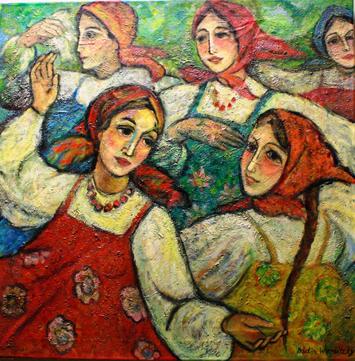
At the corner of Maitland Avenue and Maitland Boulevard, the Holocaust Memorial Center is squeezed between tennis courts and a small courtyard, part of the Jewish Community Center. Inside, the classrooms are nicely squared off. The exhibit “Two Regimes” takes up one classroom’s walls with about 40 paintings depicting life during the Stalin and Hitler regimes for Jews living in Mariupol, Ukraine. From this industrial port town on the shore of the Azov Sea to a ramshackle stilt house in north Florida, the exhibit is a strange tale, partly told.
“The exhibit will be free and available for the public to view until January 2, 2017,” stated Terrance Hunter, Program Coordinator for the Holocaust Memorial Resource and Education Center of Florida. The Center is dedicated to building an inclusive community in the Orlando area through exhibits and educational programs centered around the events of the Holocaust. This is the very first show of these paintings by the artist, and the Holocaust Center, through a State of Florida Grant, is preparing classroom curriculum materials using the paintings to help children better understand this terrible period.
Artist Nadia Werbitzky’s forty-odd paintings soulfully illuminate her mother’s memoirs of the times between the two world wars. After surviving several concentration camps, Werbitzky and her mother emigrated first to Germany, then to Canada, ending up in Baltimore. How her paintings came to rest under a Florida Cracker stilt house is still a bit of a mystery, confessed exhibit co-curator Kelly Bowen in a recent talk about the art.
The work was discovered by Mimi Shaw, then an acting coach in Tallahassee in the late 1990s. A student advised her of an interesting garage sale, so she went, and discovered Teodora’s memoirs and much of Nadia’s paintings, slowly rotting in an old house about to be demolished. Foresight and determination helped Shaw and her friend Bowen rescue, and eventually restore, the artwork.
Werbitzky studied at the Art Academy of Dusseldorf after the end of World War 2, developing her own style that references European masters like Van Gogh and Matisse. Haunted by her memories she carefully depicted real people in real events. When her work was subjected to authoritative Holocaust scholarship, the people she claimed to have painted were found to be real, and so are memorialized, as she put it, as “people who lived and breathed on this earth.”
So much of our Holocaust education is about numbers: six million Jews; twenty-three main concentration camps, and so on. The suffering, however, cannot be abstracted into numbers and are brought to extraordinary life in Werbitzky’s beautiful paintings. “Hell’s Threshold” is a good example. It depicts the October 1941 Nazi roundup of 7,500 Jews in Mariupol. Standing in the back of the line, the woman in the pink dress was a friend of Teodora’s, and later verified by others. In a blue dress, a woman rushes around the corner to the back of the line with a young baby in her arms and pulling her daughter, who is clutching a large doll. Again, a specific memory of a specific person: this time, herself.
The book “Two Regimes” puts the paintings and memoirs together, bringing old Russia to life, both good and bad. This touring exhibit evokes awe for its subjects and respect for the calm approach the curators have taken to restore and exhibit Verbitzky’s work. Two Regimes is worth seeing for both its artistic depth and its unique eye on this terrible time. If it happened then, it could happen again.
This article first appeared in The Orlando Weekly.
Richard Reep is an architect with VOA Associates, Inc. who has designed award-winning urban mixed-use and hospitality projects. His work has been featured domestically and internationally for the last thirty years. An Adjunct Professor for the Environmental and Growth Studies Department at Rollins College, he teaches urban design and sustainable development; he is also president of the Orlando Foundation for Architecture. Reep resides in Winter Park, Florida with his family.
Image: Nadia Werbitzky












